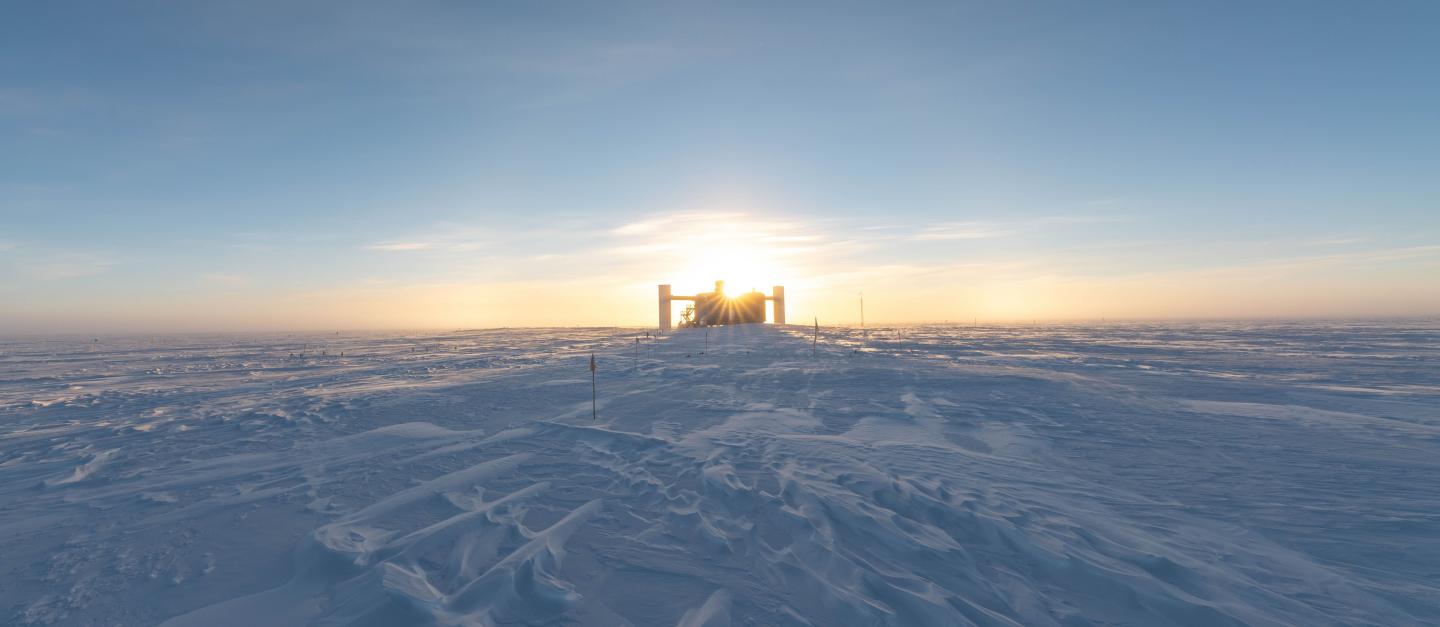First enhancement of the particle detector at the South Pole is primarily aimed at investigating neutrino oscillation

Credit: photo/©: Benjamin Eberhardt, NSF
The South Pole IceCube neutrino telescope will get an upgrade: The U.S. National Science Foundation (NSF) has agreed to grant 23 million US dollars for extending the capabilities of the observatory. The work on enhancing the detector in the Antarctic ice will cost a total of 40 million US dollars, with German research institutions contributing substantial funding. The resources will be used to install even more light sensors to capture the traces left by neutrinos arriving from space. Scientists at Johannes Gutenberg University Mainz (JGU) participating in research at IceCube expect it to provide further information about the properties of neutrinos.
IceCube is the largest particle detector in the world. It was completed in December 2010 and has been collecting data on neutrinos ever since. Neutrinos are particles that have practically no mass, enabling them to pass through matter almost unnoticed. That makes them extremely difficult to detect. These so-called ghost particles originate from distant regions of the universe and can arrive on Earth more or less unhindered, thus providing us with information about distant galaxies. On 22 September 2017, IceCube made a particularly important discovery: The detectors registered a high-energy neutrino that in all likelihood originated from a galaxy 5.7 billion light years away in the constellation of Orion.
IceCube extends over one cubic kilometer of ice and is located directly adjacent to the Amundsen-Scott South Pole Station. The station is financed by the USA, but it is available to researchers from around the world. IceCube is composed of 60 spheres of glass attached to 86 cables, which extend to depths of 1.45 to 2.45 kilometers. These spheres contain highly sensitive light sensors that are able to recognize the bluish Cherenkov light generated by neutrino reactions. The existing 5,160 sensors will be supplemented during the upgrade with a further 700 new sensors attached in close proximity to one another on seven cables. They will be installed approximately 1.6 kilometers below the center of the current detector. Work on this upgrade started in fall 2018, with the support of the NSF and other partners, including Germany. Deep ice at the South Pole is crystal clear, making it ideal for the project.
Neutrino oscillation still puzzles scientists
Neutrinos are not only challenging to detect, they also pose many puzzles – some of which, at least, may be solved with the upgrade. The main goal of this first IceCube enhancement is to get to the bottom of a phenomenon known as neutrino oscillation, according to which neutrinos oscillate between three ‘flavors’: electron, muon, and tau neutrinos.
A second goal is to provide a more accurate analysis of the ice surrounding the light sensors, which will improve measurements from the existing detector. This will benefit high-energy neutrino astronomy in particular.
JGU researchers are involved in both the IceCube upgrade and the future IceCube-Gen2
The new additional light sensors will significantly increase sensitivity, especially at low energies in the range of five to ten gigaelectronvolts. In this energy range, IceCube scientists will be able to detect neutrino oscillations of atmospheric neutrinos. Neutrino oscillations are a quantum effect that earned its discoverers the 2015 Nobel Prize in Physics. “Analyzing this type of neutrino oscillation provides us with insights into the properties of neutrinos, and this is the main focus of scientists from Mainz working at IceCube,” said Professor Sebastian Böser of the Institute of Physics at Mainz University. “We will get more neutrinos at low energies, and we expect to learn a lot from them.”
The Mainz Neutrino group was able to establish before the upgrade that this improvement will help in determining the order of the masses of the neutrino flavors. “We anticipate that after the upgrade, through our research at IceCube in conjunction with the JUNO experiment currently under construction, we will be able to categorically clarify the issue of mass hierarchy,” stated Böser. Researchers from Mainz are also playing a significant role in the JUNO experiment in China. But the scientists are also expecting to answer other research questions, such as the hypothesis that neutrinos may not only oscillate between flavors but may also disappear completely instead of undergoing transformation. Once it is possible to detect tau neutrinos at previously unprecedented rates, significant progress is expected in this field.
“This upgrade will also help us develop the technology for IceCube’s next upgrade, the IceCube-Gen2 detector,” added Professor Lutz Köpke, another neutrino researcher at the JGU Institute of Physics. To achieve this, Mainz researchers have contributed 14 novel light sensors or Wavelength-shifting Optical Modules (WOMs), which will be installed in the ice. These WOMs use advanced materials to achieve lower detector noise thanks to their increased sensitivity. “Noise is the key factor in our ability to detect supernovas – another focus of our research here in Mainz,” said Böser. The experience gained with the upgrade should help scientists in developing IceCube-Gen2, which will multiply the volume of IceCube by a factor of ten.
The Neutrino group at Johannes Gutenberg University Mainz is supported by the Federal Ministry of Education and Research (BMBF).
###
Media Contact
Professor Dr. Sebastian Böser
[email protected]




